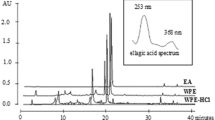Abstract
This study compared the antioxidative activity of green tea catechin (GTC) extract with that of rosemary extract in canola oil, pork lard, and chicken fat. The GTC extract was obtained from jasmine and longjing green teas and mainly consisted of four epicatechin isomers including (−)epigallocatechin gallate (EGCG), (−)epigallocatechin (EGC), (−)epicatechin (EC), and (−)epicatechin gallate (ECG). The oxidation was conducted at 100 ± 2°C by monitoring oxygen uptake. The oxygen consumption test demonstrated that GTC extract was much more effective than the rosemary extract against lipid oxidation in canola oil, pork lard, and chicken fat under the conditions of the present study. Together with our previous study which showed that GTC extract was more protective than butylated hydroxytoluene as an antioxidant, these results suggest that GTC as a mixture of EGCG, EGC, EC, and ECG may serve as an antioxidant in processed foods.
Similar content being viewed by others
References
Imai, K., and K. Nakachi, Cross Sectional Study of Effects of Drinking Green Tea on Cardiovascular and Liver Disease, Biochem. Med. J. 310:693–696 (1995).
Kono, S., K. Shinchi, N. Ikeda, F. Yanai, and K. Imanishi, Green Tea Consumption and Serum Lipid Profile: A Cross-Sectional Study in Northern Kyushu, Japan. Prev. Med. 21:526–531 (1992).
Brown, M.S., and J. Goldstein, Lipoprotein Metabolism in the Macrophage, Annu. Rev. Biochem. 52:223–261 (1993).
Jialal, I., and S. Sevaraj, Low-Density Lipoprotein Oxidation, Antioxidants, and Atherosclerosis: A Clinical Biochemistry Perspective, Clin. Chem. 42:498–506 (1996).
Steinberg, D., S. Parthasarathy, T.W. Carew, J.C. Khoo, and J.L. Witztum, Beyond Cholesterol: Modification of Low-Density Lipoprotein That Increase Its Atherogenicity, N. Engl. J. Med. 320:915–924 (1989).
Witztum, J.L., and D. Steinberg, Role of Oxidized Low-Density Lipoprotein in Atheroclerosis, J. Clin. Invest. 88:1785–1792 (1991).
Hertog, M.G.L., E.J.M. Feskens, P.C.H. Hollman, M.B. Katan, and D. Kromhout, Dietary Antioxidant Flavonoids and Risk of Coronary Heart Disease: The Zutphen Elderly Study, Lancet 342:1007–1011 (1993).
Serafini, M., A. Ghiselli, and A. Ferro-luzzi, In vivo Antioxidant Effect of Green and Black Tea in Man, Eur. J. Clin. Nutr. 50:28–32 (1996).
Zhang, A., P.T. Chan, Y.S. Luk, W.K.K. Ho, and Z.Y. Chen, Inhibitory Effect of Jasmine Green Tea Epicatechin Isomers on LDL-Oxidation, J. Nutr. Biochem. 8:334–340 (1997).
Ding, Z.Y., Y. Chen, M. Zhou, and Y.Z. Fang, Inhibitory Effect of Green Tea Polyphenol and Morin on the Oxidative Modification of Low-Density Lipoprotein, Chin. J. Pharm. Toxicol. 6:263–266 (1992).
Miura, S., J. Watanabe, T. Tomita, M. Sano, and S. Tomita, The Inhibtory Effects of Tea Polyphenols (flavan-3-ol derivatives) on Cu++ Mediated Oxidative Modification of Low-Density Lipoproteins, Bio. Phar. Bull. 17:1567–1572 (1994).
Lunder, T.L., Catechin of Green Tea, in Phenolic Compounds in Food and Their Effects on Health II, edited by C.-T. Ho, C.Y. Lee, and M.T. Huang, American Chemical Society, Washington, D.C., 1992, pp. 114–120.
Tanizawa, H., S. Toda, Y. Sazuka, T. Taniyama, T. Hayashi, S. Arichi, and Y. Takino, Natural Antioxidants I. Antioxidative Components of Tea Leaf, Chem. Pharm. Bull. 32:2011–2014 (1984).
Chen, Z.Y., P.T. Chan, H.M. Ma, K.P. Fung, and J. Wang, Antioxidative Effect of Ethanol Tea Extracts on Oxidation of Canola Oil, J. Am. Oil Chem. Soc. 73:375–380 (1996).
Chen, Z.Y., and P.T. Chan, Antioxidative Activity of Green Tea Catechins in Canola Oil, Chem. Phys. Lipids 82:163–172 (1996).
Chipault, J.R., G.R. Mizuno, and W.O. Lundberg, The Antioxidant Properties of Species in Foods, Food Technol. 10:209–211 (1956).
Nakatani, N., Natural Antioxidants from Spices, in Phenolic Compounds in Food and Their Effects on Health II, edited by C.-T. Ho, C.Y. Lee, and M.T. Huang, American Chemical Society, Washington, D.C., 1992, pp. 72–86.
Nakatani, N., and R. Inatani, Constituents of Pepper. Part III. Isobutyl Amides from Pepper, Agric. Biol. Chem. 45:1473–1476 (1981).
Inatani, R., N. Nakatani, H. Fuwa, and H. Seto, Constituents of Spices of the Family Labiatae. Part I. Structure of a New Antioxidative Phenolic Diterpene Isolated from Rosemary (Rosmarinus officialis L.), Agric. Biol. Chem. 46:1661–1666 (1982).
Houlihan, C.M., C.T. Ho, and S.S. Chang, Elucidation of the Chemical Structure of a Novel Antioxidant, Rosmaridiphenol, Isolated from Rosemary, J. Am. Oil Chem. Soc. 61:1036–1039 (1984).
Houlihan, C.M., C.T. Ho, and S.S. Chang, The Structure of Rosemariquinone—A New Antioxidant Isolated from Rosemarinus officinalis L., Ibid.:96–98 (1984).
Wu, J.W., M.H. Lee, C.T. Ho, and S.S. Chang, Elucidation of the Chemical Structures of Natural Antioxidants from Rosemary, Ibid.:339–345 (1982).
Chang, S.S., B. Ostric-Matijaseric, O.A.L. Hsieh, and C.-L. Huang, Natural Antioxidants from Rosemary and Sage, J. Food Sci. 42:1102–1106 (1977).
Agarwal, R., S.K. Katiyar, S.I.A. Zaidi, and H. Mukntar, Inhibition of Skin Tumor Promotor-Caused Induction of Epidermal Ornithine Decarboxylase in SENCAR Mice by Polyphenolic Fraction Isolated from Green Tea and Its Individual Epicatechin Derivatives, Cancer Res. 52, 3582–3588 (1992).
Chen, Z.Y., W.M.N. Ratnayake, and S.C. Cunnane, Oxidative Stability of Flaxseed Lipids During Baking, J. Am. Oil Chem. Soc. 71:629–632 (1994).
Botma, Y., Antioxidants in Food in 85 Nations, Jan Dekker International BV, Wormerveer, Holland, 1990.
Xie, B., H. Shi, Q. Chen, and C.T. Ho, Antioxidant Properties of Fractions and Polyphenol Constituents from Green, Oolong and Black Teas, Proceedings of the National Science Council, Republic of China, Part B: Life Science 17, 1993, pp. 77–84.
Graham, H.N., Green Tea Composition, Consumption and Polyphenol Chemistry, Prev. Med. 21:334–350 (1992).
Author information
Authors and Affiliations
Corresponding author
About this article
Cite this article
Chen, ZY., Wang, LY., Chan, P.T. et al. Antioxidative activity of green tea catechin extract compared with that of rosemary extract. J Amer Oil Chem Soc 75, 1141–1145 (1998). https://doi.org/10.1007/s11746-998-0303-5
Received:
Accepted:
Issue Date:
DOI: https://doi.org/10.1007/s11746-998-0303-5




